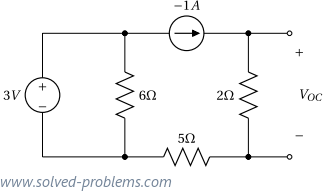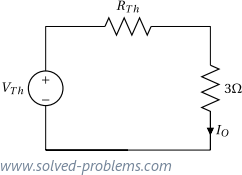Use Thévenin’s theorem to determine ![]() .
.

Solution
Lets break the circuit at the ![]() load as shown in Fig. (1-27-2).
load as shown in Fig. (1-27-2).
You may also watch the video of solving the problem below:
Also pdf version of the solution is available here.

Now, we should find an equivalent circuit that contains only an independent voltage source in series with a resistor, as shown in Fig. (1-27-3).

Unknowns are ![]() and
and ![]() .
. ![]() is the open circuit voltage
is the open circuit voltage ![]() shown in Fig. (1-27-2).
shown in Fig. (1-27-2).
It is trivial that the current of ![]() resistor is equal to the current of the current source, i.e.
resistor is equal to the current of the current source, i.e. ![]() . Therefore,
. Therefore, ![]() . The Thévenin theorem says that
. The Thévenin theorem says that ![]() . Please note that it is not saying that
. Please note that it is not saying that ![]() is the voltage across the load in the original circuit (Fig. (1-27-1)).
is the voltage across the load in the original circuit (Fig. (1-27-1)).
To find the other unknown, ![]() , we turn off independent sources and find the equivalent resistance seen from the port, as this is an easy way to find
, we turn off independent sources and find the equivalent resistance seen from the port, as this is an easy way to find ![]() for circuits without dependent sources. Recall that in turning independent sources off, voltage sources should be replace with short circuits and current sources with open circuits. By turning sources off, we reach at the circuit shown in Fig. (1-27-4).
for circuits without dependent sources. Recall that in turning independent sources off, voltage sources should be replace with short circuits and current sources with open circuits. By turning sources off, we reach at the circuit shown in Fig. (1-27-4).

The ![]() resistor is short circuited and the
resistor is short circuited and the ![]() one is open. Therefore, their currents are zero and
one is open. Therefore, their currents are zero and ![]() .
.
Now that we have found ![]() and
and ![]() , we can calculate
, we can calculate ![]() in the original circuit shown in Fig. (1-27-1) using the Thévenin equivalent circuit depicted in Fig. (1-27-3). It is trivial that
in the original circuit shown in Fig. (1-27-1) using the Thévenin equivalent circuit depicted in Fig. (1-27-3). It is trivial that![]() .
.
We used the Thévenin Theorem to solve this circuit. A much more easier way to find ![]() here is to use the current devision rule. The current of the current source is divided between
here is to use the current devision rule. The current of the current source is divided between ![]() and
and ![]() resistors. Therefore,
resistors. Therefore,![]()
Now, replace the current source with a ![]() voltage source as shown below and solve the problem. The answers are
voltage source as shown below and solve the problem. The answers are ![]() ,
, ![]() and
and ![]() . Please let me know how it goes and leave me a comment if you need help 🙂
. Please let me know how it goes and leave me a comment if you need help 🙂

Leave a Reply